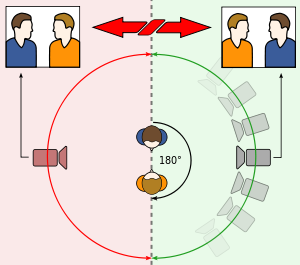Here is the final and finished product of our Preliminary task showing the: 180 degree rule, shot reverse shot, match on action and eye-line match.
Friday, 18 December 2015
The Film
Here is the final and finished product of our Preliminary task showing the: 180 degree rule, shot reverse shot, match on action and eye-line match.
Thursday, 10 December 2015
Prop Preparation.
Gun: This will be used by Tyler when he attempts to kill the protagonists. This will be sourced from home. It is important that the prop gun resembles a semi-automatic as it would be far fetched if Tyler missed the target with an automatic.

Rope: This will be used to tie up Matthew to the chair otherwise without the rope, it wouldn't give the impression of an interrogation happening/has happened. This will also be sourced from home.

Chair: This will be sourced from the college. This is what Matthew will be tied to.
Costume: The costumes of the protagonists should be casual. The costume of the antagonist should be dark clothing which will be sourced by the actor of the antagonist themselves. The dark clothing will create a sense of evil in him.

Rope: This will be used to tie up Matthew to the chair otherwise without the rope, it wouldn't give the impression of an interrogation happening/has happened. This will also be sourced from home.

Chair: This will be sourced from the college. This is what Matthew will be tied to.
Costume: The costumes of the protagonists should be casual. The costume of the antagonist should be dark clothing which will be sourced by the actor of the antagonist themselves. The dark clothing will create a sense of evil in him.
Story Board
Shot 1: Tracking shot lasting 3 seconds, LS, Eye-Level, follows Zach along the corridor.
Shot 2: Still shot lasting 2 seconds, LS, Eye-level, shows Zach's head movement as he turns.
Shot 3: Hand held shot lasting 5 seconds, MLS, Eye-level, Match on action as Zach turns his head.
Shot 4: Pan of Zach as he walks through the door, lasting 3 seconds, LS, High Angle.
Shot 5: Clearly handheld pan, as if POV of Zach from Tyler's perspective, lasting 7 seconds, ELS, very high angle.
Shot 6: Still shot lasting 1 second as Zach opens curtain, MS, Eye-level.
Shot 7: Tracking shot of Zach's hand lasting 1 second, jump cut with match on action, CU, Eye-level.
Shot 8: Still shot showing Mathew tied to the chair, lasting 2 seconds, MS, Eye-level.
Shot 9: Still shot lasting 3 seconds, dialogue, 2 shot, LS, Eye-level.
Shot 10: Still shot lasting 3 seconds, dialogue, over the shoulder shot, MCU, Eye-level, shot to be followed by reverse shot.
Shot 11: Still shot lasting 2 seconds, dialogue, over the shoulder shot, MC, Eye-level.
Shot 12: Still shot lasting 3 seconds, dialogue, over the shoulder shot, MC, Eye-level.
Shot 13: Still shot lasting 3 seconds, dialogue, over the shoulder of rope being removed off of Mathew, MC, Eye-level.
Shot 14: Handheld shot lasting 3 seconds, dialogue, over the shoulder of Mathew pointing towards Tyler, MC, High angle.
Shot 15: Handheld shot lasting 1 second, CU, High angle.
Shot 16: Still shot lasting 3 seconds, ELS, Low angle.
Shot 17: Still shot lasting 4 seconds, CU, Eye-level.
Shot 18: Still shot lasting 4 seconds, LS, Low angle.
Shot 19: Handheld shot lasting 3 seconds, MS, Eye-level.
Shot 20: Still shot lasting 5 seconds, LS, Eye-level.
Wednesday, 9 December 2015
Risk Assesment
Here is a clear and simple list of the main risks that we discovered in The Hub today. These hazards could cause injuries and make working conditions unsafe whilst filming:
2) There are cables which are taped down on the main stage area, will be our main setting. Although they are taped down, the tape can still create a trip hazard when filming. The surface of the stage is very slippery due to the lack of material. So we will all take care when making quick movements on the floor.
Monday, 7 December 2015
The Script
The Script
Zach walks along corridor
Matthew: *Muffled screaming from inside hub*
Zach goes into the hub towards where the noise came from behind the curtains. He walks slowly towards the front and opens the curtain.
Matthew: *Muffled Shouting* (Matthew's mouth is roped shut)
Zach: *Shouting* Matthew! What are you doing here?
Matthew: *Muffled noises* (Glaring behind Zach)
Zach: (Questioning) Why are you tied to a chair? How did you get here?
Matthew: *Muffled noises* (Showing more concern - facial expression)
Zach: Who did this to you? *Removes Rope*
Matthew: *Breathes in* T-t-ty-tyler (struggling to say name), *shouts aggressively* it was TYLER! (points over Zach's shoulder)
Zach: (Turns around quickly)
*Tyler appears*
Tyler: (fires weapon)
*Matthew gets shot and Zach goes flying backwards*
Zach walks along corridor
Matthew: *Muffled screaming from inside hub*
Zach goes into the hub towards where the noise came from behind the curtains. He walks slowly towards the front and opens the curtain.
Matthew: *Muffled Shouting* (Matthew's mouth is roped shut)
Zach: *Shouting* Matthew! What are you doing here?
Matthew: *Muffled noises* (Glaring behind Zach)
Zach: (Questioning) Why are you tied to a chair? How did you get here?
Matthew: *Muffled noises* (Showing more concern - facial expression)
Zach: Who did this to you? *Removes Rope*
Matthew: *Breathes in* T-t-ty-tyler (struggling to say name), *shouts aggressively* it was TYLER! (points over Zach's shoulder)
Zach: (Turns around quickly)
*Tyler appears*
Tyler: (fires weapon)
*Matthew gets shot and Zach goes flying backwards*
Thursday, 3 December 2015
Location Scouting
LOCATION
We chose the hub for our main location as it doesn't directly show that it is set in a college.

The hub is the school's performing arts studio and we will be using it to shoot our film in as it has all the resources such as space, lighting and vertigo areas to shoot from. Also the setting of the Hub doesn't appear to be from a college which makes it seem it's outside of college which brings a different atmosphere to the film.
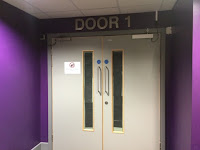
We have made use of the large doors in the Hub for our antagonists and protagonists to enter and exit the film from. I think these doors are a great decision to use as they are very spacious and once opened you have enough room to acknowledge the scenery behind the door as well as the character coming through.
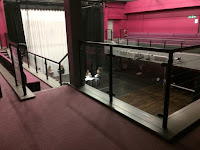
This shot from inside the Hub illustrates why we have chosen this area of the college to shoot. We needed a large curtain for a dramatic character reveal and the curtain is provided. Also the vast accessibility to lighting makes the Hub excellent as we need an intense light at some point in the scene to create a dramatic atmosphere. Also the stands higher up create a fantastic opportunity to implement high angle/eye line match shots with dialogue. We wanted this to create a sense of a character hierarchy and to tell who the protagonists is and who the antagonist are.

This will be the area that starts the film with an establishing shot. This part of the Hub is vital to the film as in the short sequence this area is used to shoot we will be introducing the protagonist and the scenery in one shot to give context to the film. In addition, the staircase behind the door could be used as a dramatic entrance for the main character to enter which give the audience a chance to fully embrace him from his body language, facial expression and costume.
We chose the hub for our main location as it doesn't directly show that it is set in a college.

The hub is the school's performing arts studio and we will be using it to shoot our film in as it has all the resources such as space, lighting and vertigo areas to shoot from. Also the setting of the Hub doesn't appear to be from a college which makes it seem it's outside of college which brings a different atmosphere to the film.

We have made use of the large doors in the Hub for our antagonists and protagonists to enter and exit the film from. I think these doors are a great decision to use as they are very spacious and once opened you have enough room to acknowledge the scenery behind the door as well as the character coming through.

This shot from inside the Hub illustrates why we have chosen this area of the college to shoot. We needed a large curtain for a dramatic character reveal and the curtain is provided. Also the vast accessibility to lighting makes the Hub excellent as we need an intense light at some point in the scene to create a dramatic atmosphere. Also the stands higher up create a fantastic opportunity to implement high angle/eye line match shots with dialogue. We wanted this to create a sense of a character hierarchy and to tell who the protagonists is and who the antagonist are.

This will be the area that starts the film with an establishing shot. This part of the Hub is vital to the film as in the short sequence this area is used to shoot we will be introducing the protagonist and the scenery in one shot to give context to the film. In addition, the staircase behind the door could be used as a dramatic entrance for the main character to enter which give the audience a chance to fully embrace him from his body language, facial expression and costume.
Wednesday, 2 December 2015
Allocated Roles
Jack:
Location scout: This job requires analyzing possible locations where shooting can take place. This job will be broken down by selecting areas around the Central Sussex College campus that are in relation with the storyboard. This will also mean taking into account how busy the area is, how weather impacts on the scene and finally how accessible a location is to shoot.
Casting director: This job requires casting suitable actors and actresses around the college to partake in the shooting of the one minute preliminary. In order to do this I will evaluate possible people for roles in the sequence. A place to look can be within the performing arts side of the college. I believe this will be an effective way to cast as these students will have experience being in front of the camera and in addition, they will also find the opportunity as a way to develop their acting skills.
Emily:
Camera Operator: This job will require Emily to shoot the one minute preliminary. In doing so she will have to incorporate the rules we have learned throughout the past weeks including reverse shots, match on action and the 180 degree rule. In addition to this she will also have to take into account camera angles so that we can a diverse sequence.
Storyboard Artist: This job will require Emily to plan out the entire of the one minute preliminary sequence by using illustration to portray this. Emily will create this storyboard through the form of post-it notes so that we have accessibility to move the story around so we can alter things.
Nathan:
Director of Filming: This job requires Nathan to maintain control throughout the process of the shooting. This is an important job because it means that he will have to over-look how the film is shot and the organization of the process and make sure deadlines are met.
Harry:
Sound Recorder: This job requires Harry to make sure that when shooting the sound is crisp and at a high standard quality. If this job isn't done correctly then the sound may corrupt and the film will be unusable so having Harry doing this job allows us to have full control over how sound is captured and relayed into the editing software.
Prop Manager: This job requires Harry to make sure that if we are in need of a prop whilst shooting then he is able to go out and get it for filming purposes. This is an important job because if props aren't accessible to us whilst on the set shooting then it will make it hard to bring certain scenes to life and bring a sense of reality to the scene so it's important this job as well as the rest are done to perfection.
Location scout: This job requires analyzing possible locations where shooting can take place. This job will be broken down by selecting areas around the Central Sussex College campus that are in relation with the storyboard. This will also mean taking into account how busy the area is, how weather impacts on the scene and finally how accessible a location is to shoot.
Casting director: This job requires casting suitable actors and actresses around the college to partake in the shooting of the one minute preliminary. In order to do this I will evaluate possible people for roles in the sequence. A place to look can be within the performing arts side of the college. I believe this will be an effective way to cast as these students will have experience being in front of the camera and in addition, they will also find the opportunity as a way to develop their acting skills.
Emily:
Camera Operator: This job will require Emily to shoot the one minute preliminary. In doing so she will have to incorporate the rules we have learned throughout the past weeks including reverse shots, match on action and the 180 degree rule. In addition to this she will also have to take into account camera angles so that we can a diverse sequence.
Storyboard Artist: This job will require Emily to plan out the entire of the one minute preliminary sequence by using illustration to portray this. Emily will create this storyboard through the form of post-it notes so that we have accessibility to move the story around so we can alter things.
Nathan:
Director of Filming: This job requires Nathan to maintain control throughout the process of the shooting. This is an important job because it means that he will have to over-look how the film is shot and the organization of the process and make sure deadlines are met.
Harry:
Sound Recorder: This job requires Harry to make sure that when shooting the sound is crisp and at a high standard quality. If this job isn't done correctly then the sound may corrupt and the film will be unusable so having Harry doing this job allows us to have full control over how sound is captured and relayed into the editing software.
Prop Manager: This job requires Harry to make sure that if we are in need of a prop whilst shooting then he is able to go out and get it for filming purposes. This is an important job because if props aren't accessible to us whilst on the set shooting then it will make it hard to bring certain scenes to life and bring a sense of reality to the scene so it's important this job as well as the rest are done to perfection.
Shot/Reverse Shot
Shot/Reverse Shot
Shot/Reverse Shot is a continuity editing technique where one character is shown looking at another character, this is often off-screen, and then the other character is shown looking back at the first character. The first shot is the main shot, it then transitions into the reverse shot, this then shows what they are looking at. For example: another character.
Shot/Reverse Shot aims to deemphasise transitions between shots to the extent that the spectator gets the scene that can be interpreted linearly, chronologically and logically.
This diagram shows clearly how shot/reverse shot works. It is showing the points in which you should film from.
Shot/Reverse Shot is a continuity editing technique where one character is shown looking at another character, this is often off-screen, and then the other character is shown looking back at the first character. The first shot is the main shot, it then transitions into the reverse shot, this then shows what they are looking at. For example: another character.
Shot/Reverse Shot aims to deemphasise transitions between shots to the extent that the spectator gets the scene that can be interpreted linearly, chronologically and logically.
This diagram shows clearly how shot/reverse shot works. It is showing the points in which you should film from.
Match on Action
Match on Action
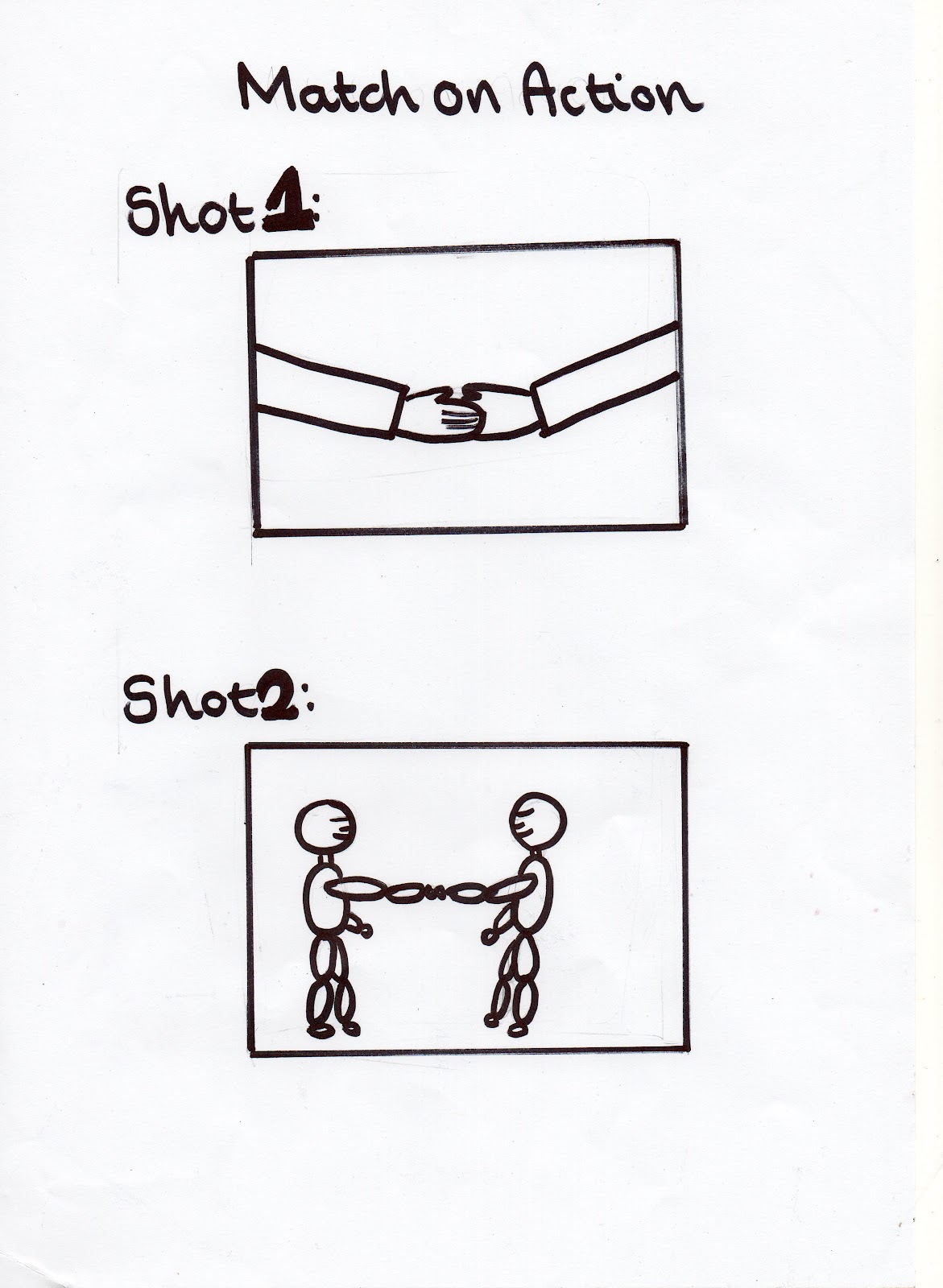 Match on action is an essential part of continuity editing which creates flow in a piece of film. A shot will end with one action, usually performed by a character in the scene, and then the next shot will begin with a continuation of the same action. This seamless cut will take the spectators attention away from the transition, instead keeping their mind on what's happening in the story.
Match on action is an essential part of continuity editing which creates flow in a piece of film. A shot will end with one action, usually performed by a character in the scene, and then the next shot will begin with a continuation of the same action. This seamless cut will take the spectators attention away from the transition, instead keeping their mind on what's happening in the story.
As the audience, we are solely focused on the action being performed by the characters. By cutting part way through a certain movement, our concentration is kept on this action.
 Match on action is an essential part of continuity editing which creates flow in a piece of film. A shot will end with one action, usually performed by a character in the scene, and then the next shot will begin with a continuation of the same action. This seamless cut will take the spectators attention away from the transition, instead keeping their mind on what's happening in the story.
Match on action is an essential part of continuity editing which creates flow in a piece of film. A shot will end with one action, usually performed by a character in the scene, and then the next shot will begin with a continuation of the same action. This seamless cut will take the spectators attention away from the transition, instead keeping their mind on what's happening in the story.As the audience, we are solely focused on the action being performed by the characters. By cutting part way through a certain movement, our concentration is kept on this action.
The 180 Degree Rule
The 180 degree rule
In film making, the 180 degree rule is a basic guideline in regards to the relationship between two characters or a character and object. An imaginary line called the axis connects the characters, and by keeping the camera on one side of this axis for every shot in the scene, the first character is always on the right of the second character who is on the left of the first character in the frame.
The camera passing over the axis is called jumping the line or crossing the line; this is breaking the 180 degree rule.
This schematic shows the axis between two characters and the 180° arc on which cameras may be positioned. When cutting from the green arc to the red arc, the characters switch places on the screen. The object that is being filmed must always remain in the center, while the camera must always face towards the object.
In a dialogue scene between two characters, Bob (orange shirt, frame left in the diagram) and Bill (blue shirt, frame right), the camera may be placed anywhere on the green 180° arc and the spatial relationship between the two characters will be consistent from shot to shot, even when one of the characters is not on screen. Shifting to the other side of the characters on a cut, so that Lucas is now on the left side and August is on the right, may disorient the audience.
The rule also applies to the movement of a character as the "line" created by the path of the character. For example, if a character is walking in a leftward direction and is to be picked up by another camera, the character must exit the first shot on frame left and enter the next shot frame right.
This is how the 180 degree rule is being used in our work:
M- Matthew
Z- Zach
T- Tyler
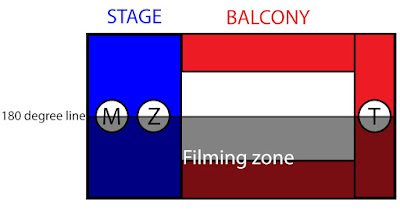
In film making, the 180 degree rule is a basic guideline in regards to the relationship between two characters or a character and object. An imaginary line called the axis connects the characters, and by keeping the camera on one side of this axis for every shot in the scene, the first character is always on the right of the second character who is on the left of the first character in the frame.
The camera passing over the axis is called jumping the line or crossing the line; this is breaking the 180 degree rule.
This schematic shows the axis between two characters and the 180° arc on which cameras may be positioned. When cutting from the green arc to the red arc, the characters switch places on the screen. The object that is being filmed must always remain in the center, while the camera must always face towards the object.
In a dialogue scene between two characters, Bob (orange shirt, frame left in the diagram) and Bill (blue shirt, frame right), the camera may be placed anywhere on the green 180° arc and the spatial relationship between the two characters will be consistent from shot to shot, even when one of the characters is not on screen. Shifting to the other side of the characters on a cut, so that Lucas is now on the left side and August is on the right, may disorient the audience.
The rule also applies to the movement of a character as the "line" created by the path of the character. For example, if a character is walking in a leftward direction and is to be picked up by another camera, the character must exit the first shot on frame left and enter the next shot frame right.
This is how the 180 degree rule is being used in our work:
M- Matthew
Z- Zach
T- Tyler

Preliminary Task in Continuity Editing
Preliminary Task in Continuity Editing
The Preliminary Task.
The specification
states that this must be:
‘ A continuity task involving filming and editing a
character opening a door, crossing a
room and sitting down in a chair opposite another character with whom she/he
then exchanges a couple of lines of dialogue.’ The sequence must last no longer
than one minute.
This task
should demonstrate:
- Match on Action
- Shot/Reverse Shot
- The 180 degree Rule
You will also have to incorporate Music, lighting, dialogue
(recorded separately on a lapel mic and voice recorder)
and sound effects into your film
All filming and editing must take place on campus,
using College equipment.
Each group will set up a
blog onto which you will record the
entire process
Subscribe to:
Comments (Atom)





